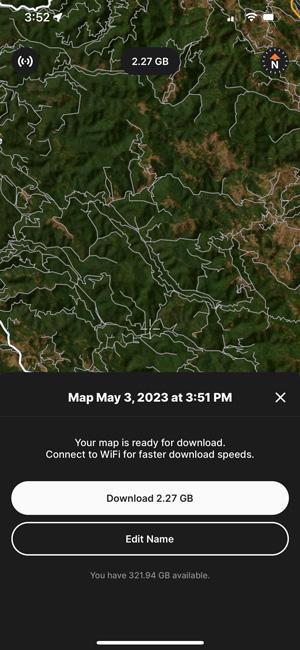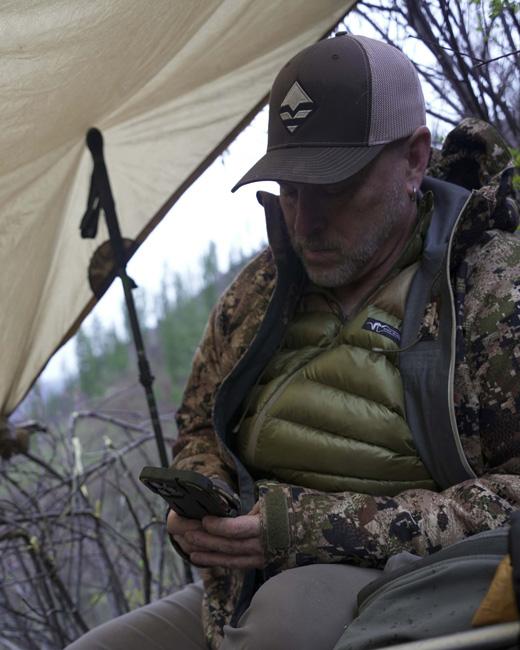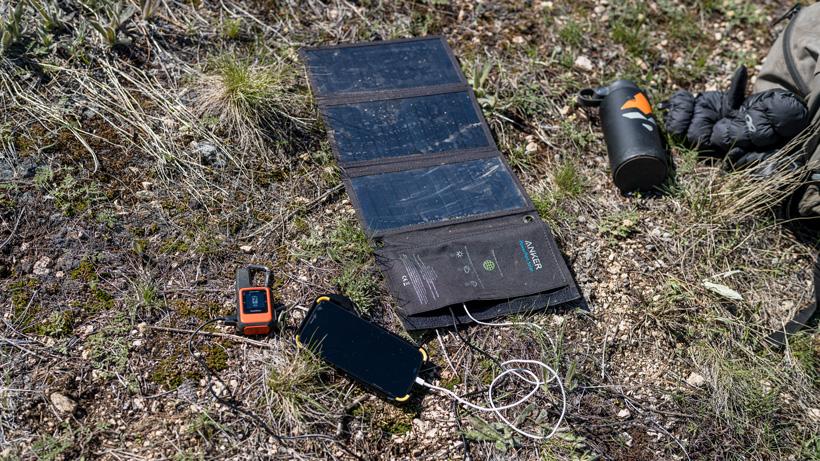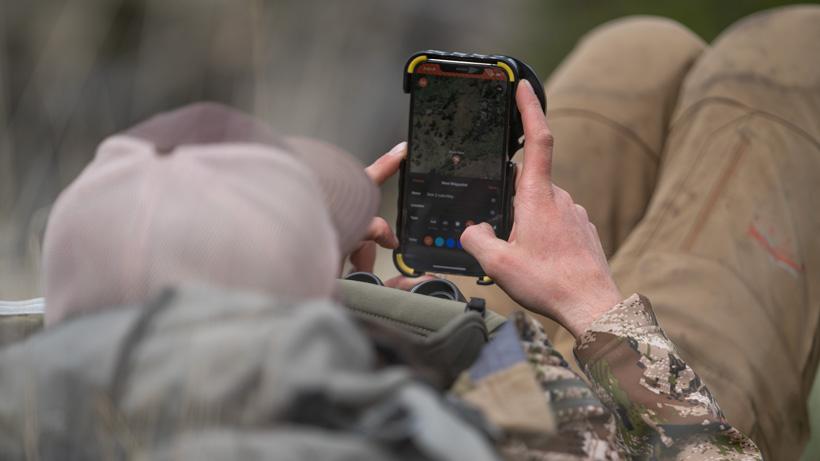



“You will never need a backup navigational device until you do; when you do, it will never be a good time.”

Download your offline satellite map and state layers ahead of time on GOHUNT Maps.


Keeping your batteries and phone charged when you get a window of sun is essential. Photo credit: Brady Miller

Photo credit: Pedro Ampuero
Hunt application technology continues to advance, and western hunters have become increasingly reliant on their electronic devices. This dependence justifies the need for a solid plan to maximize the effectiveness of these devices and conserve battery life during backcountry hunts.
Smartphones have become an indispensable tool for many western hunters, serving a variety of functions like backcountry navigation, ballistic calculations, and hunt planning. In addition, hunters are now using their phones to connect with spotting scopes and binoculars through a process called digiscoping.
Conserving battery power is important, but it's not the only device factor to consider during backcountry hunts. In this article, I'll share some tips, strategies, and recommended gear to help you manage your power needs, extend battery life and avoid potentially dangerous situations in the backcountry.
Smartphones are convenient and reliable, but can malfunction, get damaged and lost. That's why you should really consider carrying a standalone backup navigational device, such as a GPS unit or a multipurpose communication device like a Garmin inReach.
Just packing the device is not good enough. Be sure to take the time to record a few critical waypoints on your backup device, such as trailheads, parking spots and camps. Having a backup navigational device is important and it could even save your life in the backcountry.
The new trend is using these ultrasmall small satellite communicators that connect to your phone via Bluetooth. However, I advise against using units that require pairing with your phone for navigation or messaging purposes. While they are inexpensive and easy to carry due to their light weight, they should not be relied upon as standalone backup devices. Depending solely on them could lead to a disastrous outcome.
Instead, select a unit that can connect to your phone, but still has the ability to operate as a completely standalone device. The price point is attractive for the other communicators, but they are not truly stand-alone backup devices. This could be a recipe for disaster.
Personally, I recommend using a basic standalone GPS unit or a multipurpose communication device like a Garmin inReach device. The Garmin inReach Explorer+ Satellite Communicator & GPS and the Garmin inReach Mini 2 Satellite Communicator & GPS are both good choices.
Also, always carry a compass. No exceptions.
To ensure optimal performance on your backcountry trips, it's essential to take a closer look at your phone's memory usage. When the memory on your phone is close to reaching its maximum capacity, it can cause poor performance and could lead to malfunctions.
Therefore, keeping at least 1 GB of memory space available is recommended to ensure that your phone and its applications run smoothly.
Testing the limits of your phone's memory when you're off-trail and deep in the backcountry can be risky. Freeing up some space before your hunt is always a good idea and can help prevent any performance issues from arising.
Download your offline satellite map and state layers ahead of time on GOHUNT Maps.
Most western hunters are familiar with downloading offline maps in their hunt application, but not all hunters take the time to test the offline functionality and integrity of their downloaded maps.
These downloaded maps allow offline access to topography, aerial images and custom map data layers in areas without cell coverage. Even in areas with good cell coverage, it’s a good idea to download your maps as it will save device power by limiting the need to access cell towers.
However, downloading the maps is just the starting point. Testing the integrity and functionality of these maps before you hit the field could be the difference between success and failure. Most of us absolutely rely upon access to this map data in the backcountry. An offline map problem is certain to alter the integrity of your hunt.
Before the hunt, take your phone completely offline and test the functionality of your offline downloads. Make sure all your base maps and map data layers are loading properly for your entire hunt area. This small step can make a big difference on the hunt.
My next recommendation is to avoid limiting yourself to just one hunting application or platform. I suggest running two redundant hunting applications with the same offline maps and data points. This multi-dimensional backup approach is relatively cheap insurance and, more importantly, it gives you two different aerial photo views and more than likely two versions of topography maps.
On iPhones, turn on low power mode to reduce power consumption. When this mode is on, battery life is extended; however, some features may take longer to update or complete. Personally, I have not seen any hunt application performance decrease while in low power mode. When the battery is charged to 80% or higher, this mode automatically turns off and you will need to activate it again.
In the backcountry, switch your phone to airplane mode to save power. This stops your device from searching for and trying to establish a cellular network connection. Manually turn off Wi-Fi and Bluetooth connectivity to significantly improve power consumption. However, if you're using a communication device like a Garmin inReach, you may want to keep Bluetooth connection active.
Hot and cold temperatures can have a big impact on battery life. Most devices are designed to work in temperatures between 32°F and 95°F with an optimal range of 62°F to 72°F. Keeping the phone in a secure pocket instead of a pack can help maintain this range. Avoid charging the phone when it's extremely cold as this can damage the battery. Keeping your phone in your sleeping bag is a good idea.
Not all apps are created equal when it comes to battery drain. Close all unnecessary apps to reduce the device's background activity.
If you are using an iPhone go to Settings > General > Background App Refresh, then tap Background App Refresh and select Off. On Android phones, you can restrict individual apps by going to Settings > Battery > More > Battery usage. Identify the apps with high battery use and turn the background restriction on.
Do not turn off all location services. Doing this will disable the GPS connection to your hunting applications. However, for most other apps, you can reduce power demand by turning off location services. On the iPhone, go to Settings > Privacy > Location Services and select "Never" for apps you don’t need location services for. On Android devices, open Settings, then tap "Location services" or "Location access."
Having your device screen set to the brightest level can quickly drain your battery. You can improve battery life by dimming your screen. You can either manually adjust the brightness to the lowest level that allows you to see your maps or turn on auto-brightness, which automatically adapts to lighting conditions. I find that I can usually get by with less brightness than the auto setting.
Consider turning off your phone when you're not using it for longer periods of time, especially when sleeping or while charging the device. Avoid turning it on and off between routine uses as this uses significant power resources.
Keeping your batteries and phone charged when you get a window of sun is essential. Photo credit: Brady Miller
Having a backup battery device is just about mandatory. You never know when an injury or mishap could extend your backcountry trip. Relying solely on your phone's charge even for a day trip could leave you in trouble. At a minimum, bring a backup battery pack and two charging cables for added redundancy.
Charging cables are not created equal. Be sure you are using a high-quality cable to connect your device to the battery pack. The low-quality cheap versions can result in slower charging speeds, reduced efficiency or even damage to your device or battery pack.
It’s important to remember that mobile battery packs can go bad if they are left unused for long periods of time. The lithium-ion batteries will experience a natural discharge over time even when they are not being used. If the battery pack is left completely discharged for an extended period, it can cause permanent damage to the battery's chemistry, reducing its overall lifespan and performance.
To prevent your mobile battery pack from going bad when not in use, it's best to store it in a cool, dry place and make sure it's charged to at least 50% before storing it for an extended period. It's also a good idea to use your battery pack regularly to keep it in good working condition.
Lithium-ion battery packs do not need to go through full charge and discharge cycles to maintain their performance. It is recommended that you recharge them when they drop to around 20% to 30% and stop charging them when they reach around 80% to 90% of their capacity.
There is some controversy over the best, most reliable and lightest weight battery packs. My friend, Chiam Loyd, a filmmaker here in Montana, recently conducted his own battery pack performance test. Surprisingly, many battery devices do not live up to their claims and fall short by a considerable margin.
Chiam has written a great article about his findings (to be published to GOHUNT very soon) and he claims that just because a power bank claims to hold 10,000 mAh, it doesn't mean that it actually does. A good 10,000 mAh power bank will output only around 6,000 to 7,000 mAh. For perspective, the average smartphone requires about 3,227 mAh to charge fully from 0% to 100%.
Below are the two power banks that came out on top during his testing and how they performed:
You can judge the weight versus performance for yourself. Read the article when it drops in a few weeks as it is pretty eye-opening.
Most devices come equipped with tools that enable you to track which apps and functions consume the most battery power. Here's how to access these tools on iPhone and Android devices:
By reviewing your power consumption regularly, you can streamline your device's usage and extend its battery life.
Photo credit: Pedro Ampuero
My technology assets are essential to my overall western hunt strategy. A mistake or failure in my technology or navigational system would be a serious setback. I’m continually adjusting my gear setup, but this is my plan for the upcoming seasons:
On western hunts so many unknowns are beyond our control. Focusing on the aspects that are within our control will better equip you to handle the unexpected challenges that will inevitably arise.
Nitecore 10,000 mAh power bank: Price $60; weight 5.3 oz. Actual tested output 6,179 mAh
New Dark Energy 10,200 mAh Power bank: Price $130; weight 8.8 oz. Actual tested output 6,069 mAh
For iPhone users, start by launching the Settings app from your home screen. Next, tap on Battery and select the Last 10 Days tab above the graph to view the overall power consumption of various applications over the past 10 days. You can also click any of the graph bars to see day-by-day usage, which can be incredibly helpful in identifying and managing power-hogging apps.
Android users can access their device's power consumption tools by opening the Settings app, selecting Battery, and then Battery Usage (if you don't see a list of apps). From there, you can identify the apps and services that are using the most battery and tap on each item to view more details.
iPhone 13 Pro Max with 512 GB of memory
Two high-quality phone cables: one in my pack and one at basecamp.
One tested and verified cable for my Garmin inReach device.
Multiple hunting applications are installed on my phone, including GOHUNT Maps, GaiaGps, Google Earth, CalTopo, and Earthmate, which is a Garmin inReach satellite communication tool.
Before the hunt, I will verify that I am running all the up-to-date application versions.
A set of tested and verified offline map downloads and waypoints on at least two hunt platforms.
Many times, I will also put a backup copy of my hunt data on my inReach device.
Two external battery backup packs: one always carried in my pack and one at camp. I will be adding the Nitecore 10,000 mAh power bank to my gear list this season.
I keep my camp battery pack charged with solar panels. This allows me to cycle and swap out battery packs.
I have found that the Ryno Tuff Portable 21W Foldable Solar Charger (1.06 lbs) and the Big Blue 28W Solar Charger (1.48 lbs) are some of the best available. I plan to run the Ryno Tuff this season.
A compass — I always carry one!